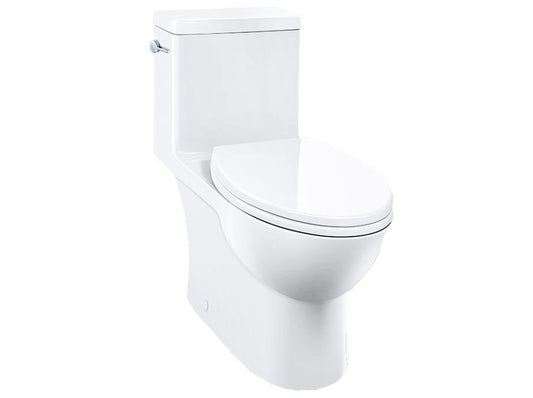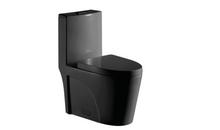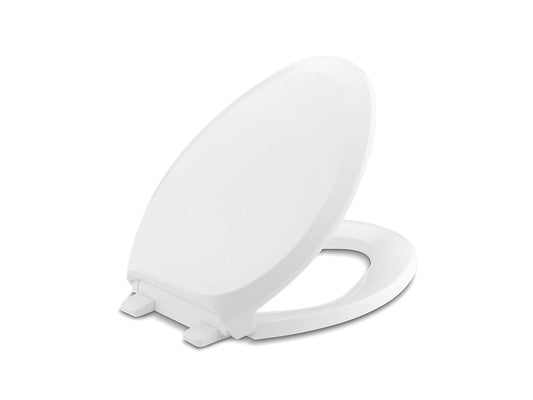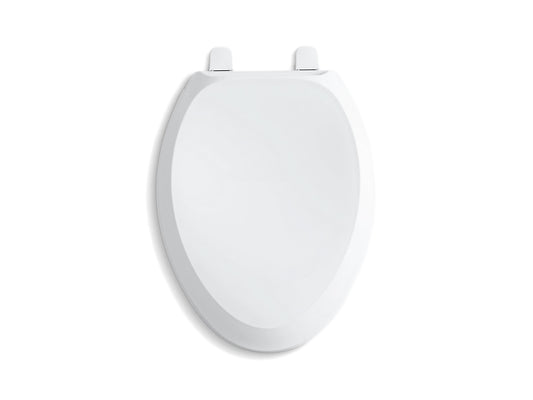-
-
17% Off17% Off17% Off17% Off17% Off17% Off17% Off17% Off17% Off
-
-
-
-
-
-
-
-
-
-
-
Elongated Toilets
Opting for an elongated toilet bowl can offer several advantages over a standard round bowl, depending on individual needs and preferences:
-
Comfort: Elongated toilet bowls provide more surface area and a larger seating area, which can enhance overall comfort during use. The elongated shape accommodates a wider range of body sizes and provides additional legroom, making it particularly beneficial for taller individuals or those who prefer a more spacious seating experience.
-
Enhanced Hygiene: The elongated shape of the bowl reduces the risk of contact between body parts and the toilet bowl surface, promoting improved hygiene and cleanliness. The larger size and shape make it easier to maintain proper personal hygiene while minimizing potential splashing or accidental contact.
-
Accessibility: Elongated toilet bowls are often recommended for individuals with mobility issues, disabilities, or elderly users who may require additional space for maneuvering or using mobility aids like grab bars. The wider seating area can offer better stability and support.
-
Aesthetics: Elongated toilet bowls are generally considered more aesthetically pleasing and modern in appearance compared to round bowls. They can provide a sleek and contemporary look to your bathroom, especially if you're aiming for a cohesive design or upgrading your fixtures.
It's worth noting that elongated toilet bowls may require slightly more space in the bathroom due to their elongated shape, so it's essential to ensure that your bathroom layout can accommodate the larger size. Ultimately, the decision to choose an elongated toilet bowl comes down to personal comfort, hygiene preferences, accessibility needs, and the overall aesthetic vision for your bathroom.
The main difference between a standard toilet and an elongated toilet is the shape of the bowl. A standard toilet bowl is more circular in shape, while an elongated toilet bowl is oval or elongated in shape. The elongated bowl provides a larger seating area, offering enhanced comfort, improved hygiene, and increased accessibility for individuals with mobility needs.
An elongated toilet refers to a type of toilet fixture that features an elongated bowl shape. Unlike a standard round toilet bowl, which is more circular in shape, an elongated toilet bowl is oval or elongated in shape. The elongated bowl provides a larger seating area and offers several benefits such as increased comfort, improved hygiene, and enhanced accessibility for individuals with mobility needs. It has become a popular choice in modern bathrooms due to its aesthetic appeal and functionality.
Elongated toilets are popular for several reasons:
-
Enhanced Comfort: Elongated toilets feature a larger bowl size and shape compared to round toilets. The elongated shape provides more surface area and additional legroom, making them more comfortable to sit on, especially for individuals with larger body frames.
-
Improved Hygiene: The elongated shape of the bowl helps reduce the likelihood of contact between the user and the inner rim of the toilet. This design minimizes the potential for splashing and makes cleaning the toilet more manageable, resulting in improved hygiene.
-
Aesthetics: Elongated toilets are often perceived as more modern and stylish compared to round toilets. The elongated shape lends a sleek and contemporary look to the bathroom, making it a popular choice for those who prioritize aesthetics in their home design.
-
Accessibility: The larger seating area and greater legroom of elongated toilets make them more accessible for individuals with mobility issues, the elderly, or those who require additional space for comfortable use. This accessibility factor contributes to their popularity in public facilities and accessible bathrooms.
-
Compatibility: Elongated toilets have become a standard option in many residential and commercial settings. This availability and widespread adoption make them a convenient choice when replacing or upgrading existing toilets, as they are readily compatible with standard plumbing and fixtures.
Overall, the increased comfort, improved hygiene, aesthetic appeal, accessibility, and compatibility of elongated toilets have contributed to their popularity among homeowners, designers, and facility managers alike.
In most cases, it is possible to replace a round toilet with an elongated toilet. However, there are a few factors to consider before making the switch:
-
Space Constraints: Measure the available space in your bathroom to ensure that there is enough room to accommodate an elongated toilet. Elongated toilets are larger and require more space, particularly in terms of depth, compared to round toilets. Make sure there is sufficient clearance between the toilet and nearby fixtures or walls.
-
Rough-In Size: Check the rough-in size of your current toilet. The rough-in refers to the distance from the wall to the center of the toilet flange, which connects the toilet to the drainage pipe. Most toilets have a standard rough-in size of 12 inches, but some older or non-standard toilets may have different rough-in sizes. Ensure that the rough-in size of the elongated toilet you intend to install matches your existing rough-in size.
-
Plumbing Compatibility: Verify that the existing plumbing setup in your bathroom is compatible with an elongated toilet. Check the water supply line, drainage pipe, and any other connections to ensure they align with the requirements of the new toilet.
-
Installation Considerations: Keep in mind that replacing a toilet involves some plumbing work. If you are not experienced with plumbing tasks, it is advisable to seek professional assistance to ensure proper installation, including sealing the toilet to the floor and connecting the water supply correctly.
By taking these factors into account and consulting with a plumber if necessary, you can determine if it is feasible to replace your round toilet with an elongated toilet in your specific bathroom configuration.
The preference for round or elongated toilets can vary among individuals and can be influenced by factors such as personal comfort, space constraints, and aesthetic preferences. However, it is worth noting that elongated toilets have gained more popularity in recent years for several reasons:
-
Comfort: Many people find elongated toilets more comfortable to sit on due to their larger bowl size and extended seating area. The elongated shape provides additional legroom and a more spacious seating surface, offering enhanced comfort during use.
-
Hygiene: The elongated shape of the bowl reduces the likelihood of contact between the user and the inner rim of the toilet, resulting in improved hygiene. This aspect can be particularly appealing for individuals who prioritize cleanliness and ease of cleaning.
-
Accessibility: Elongated toilets tend to be more accessible for individuals with larger body frames, mobility challenges, or those who require additional space for comfortable use. The larger seating area and increased legroom can make it easier for people with varying needs to use the toilet comfortably.
-
Aesthetics: Elongated toilets are often considered more modern and visually appealing compared to round toilets. The sleek, elongated shape can add a touch of elegance and sophistication to the bathroom, aligning with contemporary design trends.
While elongated toilets have seen increased popularity, it is important to note that round toilets are still widely used, especially in spaces with limited bathroom area or where retrofitting is required. Ultimately, the preference between round and elongated toilets is subjective and dependent on individual needs, space availability, and personal taste.
Compared to a round toilet, an elongated toilet typically requires an additional space of about 2 to 3 inches in terms of depth. The elongated shape extends the front of the bowl further out, providing a larger seating area and more legroom. This increased depth is necessary to accommodate the elongated bowl shape.
When considering the installation of an elongated toilet, it is crucial to measure the available space in your bathroom to ensure that there is enough room for the extended bowl. Take into account any nearby fixtures, walls, or obstructions that may impact the required space for the toilet. Adequate clearance is essential to ensure comfortable use and to allow for proper access during installation and maintenance.
Remember that the specific space requirements can vary slightly depending on the design and brand of the elongated toilet. It is advisable to consult the manufacturer's specifications and guidelines for the particular toilet model you are considering to get precise measurements and ensure a proper fit within your bathroom layout.
The shape of the toilet bowl, whether elongated or round, does not directly affect the flushing performance. The flushing efficiency of a toilet primarily depends on other factors such as the design of the flush mechanism, water flow rate, and the trapway (the passage that carries waste from the bowl to the drainage pipe). These factors determine the effectiveness of waste removal and prevent clogs.
While elongated toilets do not inherently flush better than round toilets, they may offer some advantages due to their larger bowl size. The larger surface area of an elongated toilet bowl can allow for better water coverage during flushing, which may contribute to a more effective removal of waste. Additionally, the elongated shape may provide a smoother and more direct flow of water, further assisting in waste removal.
However, it's important to note that the flushing performance can vary between different toilet models and brands. When selecting a toilet, it's advisable to consider factors like the flush rating or reviews to ensure it has a reliable and efficient flushing mechanism.
The rough-in measurement for an elongated toilet is typically the same as that of a round toilet, which is 12 inches. The rough-in refers to the distance between the wall behind the toilet and the center of the toilet flange, which connects the toilet to the drainage pipe.
In most residential settings, a 12-inch rough-in is the standard and widely used measurement. However, it's essential to note that there are cases where non-standard rough-in sizes exist, such as 10 inches or 14 inches, particularly in older homes or unique plumbing configurations.
When replacing or installing an elongated toilet, it is crucial to verify the rough-in size of your existing toilet or the rough-in distance you need for the new elongated toilet. This ensures that the toilet will align properly with the drainage pipe and the flange. By confirming the rough-in size, you can select an elongated toilet that matches your specific plumbing configuration and ensure a proper fit during installation.
















































